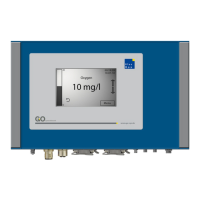BlueBox
GO Systemelektronik GmbH Faluner Weg 1 24109 Kiel Germany Tel.: +49(0)431-58080-0 Fax: -58080-11
Page 17 / 77
www.go-sys.de info@go-sys.de
4.3 Termination of the CAN-bus
It is important to “terminate” the specific modules
in the right way. Physical this means, that a mod-
ule at the beginning or the end of a bus has to be
endued with a closing resistor. With this “termina-
tion” the CAN-bus is closed, this prevents signal
reflections and signal interference.
Modules that are inside of a bus (pass modules)
may accordingly have no terminating resistor.
schematic representation of the CAN-bus line
structure, example
The on- and off-switching of the terminating resis-
tor is done with a DIP switch. This DIP switch is
located in the module housing next to the con-
nection clamps of the sensors and is labeled
"Termination".
The termination is switched on when the DIP
switch in position "ON".
The termination is switched off when the DIP
switch in position "OFF".
At the BlueBox itself, the termination resistor can
also be switched on and off. Here too, the DIP
switch is located next to the terminal to the cable
leading from the M12 connector on the mother-
board. Because the BlueBox is in the majority of
installations at the beginning of the CAN-bus, the
BlueBox is terminated at the factory, i.e. the ter-
mination resistor is switched on.
If the Blue Box is in the middle of a CAN-bus, the
termination of the BlueBox must be switched off.
see:
3.5 CAN-bus termination and RS-485 termination
at the BlueBox
DIP switch on position „ON“, the termination
resistor is switched on.
The device is a final module.
DIP switch on position „OFF“, the termination
resistor is switched on.
The device is a pass module.
Termination
CAN - Bus
OFF ON
X1
1 CAN - H
2 CAN - L
3 +24V
4 24V GND
1
2
3
4
5
6
X1
Termination
CAN - Bus
OFF ON
X1
1 CAN - H
2 CAN - L
3 +24V
4 24V GND
1
2
3
4
5
6
X1

